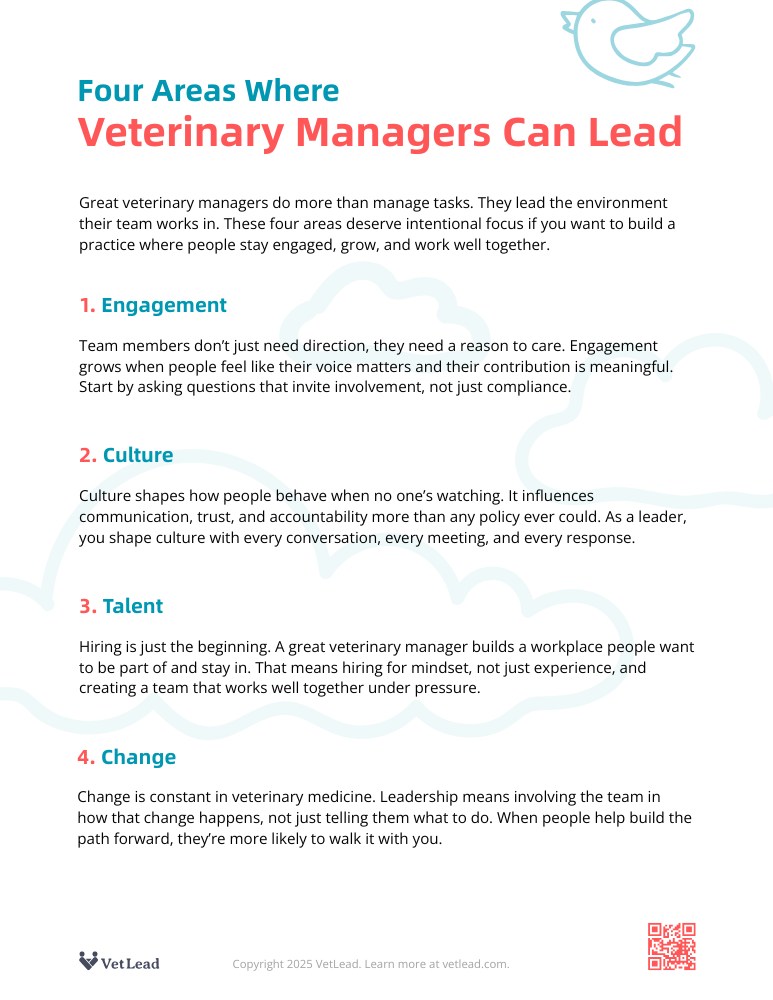If you manage a veterinary team, you’re already doing both leadership and management, whether you’ve named it that or not.
You manage the schedule. You solve problems. You keep things moving.
But when your team struggles with engagement, initiative, or accountability, that’s not a management issue. It’s a leadership moment.
Too often, veterinary managers are handed a long to-do list and called a leader. But leadership isn’t just more responsibility. It’s a different kind of work. And if you don’t know what that work looks like, it’s easy to stay stuck solving the same problems every week.
Here’s how to separate the two so you can use both more effectively.
Understand the Role of Management in a Veterinary Practice
Management is what keeps the practice operational. It’s how you organize people, processes, and resources to make the work happen. When a veterinary manager builds the schedule, tracks inventory, reviews payroll, or maintains equipment, they’re managing. Good management ensures that the right tools, people, and plans are in place to meet the day’s demands. It’s the structure that supports patient care, client service, and team performance.
But management alone isn’t enough. If it stops at maintenance, you’re constantly reacting instead of planning. Without regular analysis or forward thinking, the work becomes a cycle of urgent problems. That affects everything, from how your team engages to how smoothly appointments run.
Management creates stability. Leadership creates progress. And every great veterinary manager learns to do both.
What Leadership Looks Like in a Veterinary Practice

Leadership isn’t a job title or a senior role. It’s about helping others become better because you were part of the process.
If someone is just enforcing rules, they’re managing. If they’re helping the team grow, improve, and contribute at a higher level, they’re leading.
Leadership shows up when a veterinary manager asks:
- “What kind of culture are we creating here?”
- “How do I help this person grow into their role?”
- “What conversations do I need to have to shift this dynamic?”
Leadership creates a future that wouldn’t exist otherwise. And without it, veterinary practices stall. People disengage. Problems repeat. The workplace becomes a place to survive, not a place to succeed.
Four Areas Where Veterinary Managers Need to Lead
Let’s talk about the actual work of leadership. These are the areas that shape how your practice feels and functions. Paying attention to these areas is how leadership shows up in your day-to-day work.
1. Engagement
Engagement isn’t about whether someone shows up. It’s about how they show up. A veterinary manager can’t force motivation—but they can shape it.
The shift comes when we start asking better questions:
- “What would make team meetings more useful for you?”
- “What’s something you’d like to improve around here?”
Engagement grows when people feel involved, not when they’re told what to do. Great veterinary managers create space for that involvement.
2. Culture
Culture, not the handbook or the policies, is what shapes most of the decisions in your hospital. People take their cues from the behavior they see around them, not the rules written on paper.
If gossip is normal, it spreads. If problem-solving is encouraged, it becomes a habit. Veterinary managers influence culture by what they tolerate, what they reward, and how they respond.
This is why coaching, one-on-one conversations, and team discussions matter. Every time you reinforce what “good” looks like, you’re building a better culture in your veterinary practice.
3. Talent
Hiring based on experience alone is a coin toss. Someone may have worked in veterinary medicine for 10 years, but that doesn’t mean they’ll be a fit for your team. What matters more is how they think, how they collaborate, and whether they’re committed to growing.
Hiring may be a management task, but creating a place people want to stay is leadership. The way you build your team affects everything else, from morale to client experience to your own burnout.
4. Change
Every practice is navigating change: new systems, new staff, new expectations. But most teams experience change as something that’s done to them, not with them.
When you lead change, you involve your team in shaping the path forward. That reduces resistance and increases buy-in.
If you want the team to embrace a new workflow, ask them what would make it work. Invite feedback early. Change lasts when people help build it.

Four Ways Veterinary Managers Can Lead
Download and share with leaders and teams. No email address required.
You Can’t Lead Without Managing First
Leadership isn’t a shortcut around the hard parts of management. You can’t coach someone effectively if you don’t understand the job they’re trying to do. You can’t build a better culture if you don’t know what the current one feels like.
Management gives you the information. Leadership puts it to use.
Think of it this way: You can’t train for a triathlon if you don’t know how to swim. The skill comes first. Then you can lead others.
How Veterinary Managers Can Grow as Leaders
The best veterinary managers don’t wait for leadership moments to appear. They create them.
Here are a few simple ways to lead on purpose each week:
These aren’t time-consuming changes. They’re shifts in how you think about your role, and they can become the habits that shape how you lead each day.
Managing Keeps Things Running. Leading Moves Them Forward.
Veterinary managers hold one of the most important roles in the practice, not because they do everything, but because they shape everything.
When you manage well, your team knows what to expect. When you lead well, they’re excited about where they’re headed.
And when you do both intentionally, you create a practice where people show up with more purpose, more ownership, and more potential every day.
What do you think? Other veterinary pros want to hear from you! Share your experience in the comments below.